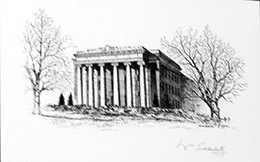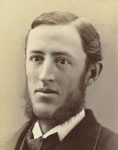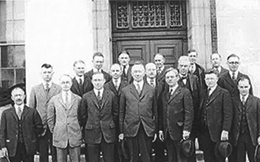A Brief History of the Department of Economics
 College of Business Building Sketch
College of Business Building Sketch
The University of Nebraska received its charter from the State Legislature in 1869, two years after Nebraska was granted statehood.
Within a few short years of founding, the economics program was established. The 1896-97 Bulletin of the university lists a major
called political and economic science, with a master’s degree offered. The 1899-1900 Bulletin changed the name of the major to political
economy and sociology, also with a master’s degree offered.
The first graduate seminar was taught by George Howard and Howard Caldwell in 1889 — a seminar in history and economics.
Amos G. Warner (1885) assisted in that first graduate seminar, and he became the head of the Department of Economics and
Political Science, which was created in 1889. Warner built up the department, but lost key faculty members in the 1890s
during a period of fiscal constraints due to drought. Thereafter, William G. Langworthy Taylor became the head of the Department
of Economic and Political Science in 1893. Taylor expanded the course offerings in economics to include: economic history, financial
history, tariff law, socialism, and money and banking. Courses in business crises, statistics and labor problems were also added by 1895.
 Anderson Clark
Anderson Clark
In 1905 when the Rev. Anderson W. Clark received his degree, the department was known as the Department of Political Economy and Sociology.
He appears to have been the first recipient of a doctoral degree from that department. Clark was a much-loved humanitarian, who founded the
Child Saving Institute in Omaha, Nebraska. The institution still serves the children of eastern Nebraska today.
Minnie Throop England was awarded her doctoral degree from the University of Nebraska Department of Political Economy and Sociology
in 1906. She published a body of influential work addressing business cycle theory. England also served on the faculty of the newly-named
Department of Political Economy and Commerce from 1906 to 1921. Her work is being rediscovered in light of recent economic developments on
business cycle theory.
 Minnie Throop England
Minnie Throop England
Later in 1906, the Department of Political Economy and Commerce was created when Department of Political Economy and Sociology was divided
into two separate departments. New courses were added to the curriculum to include: American industries, foreign commerce, private finance,
insurance, corporate finance and investments. The School of Commerce was eventually formed in 1913, with James E. LeRossignol, director,
offering the first bachelor’s degree through the College of Arts and Sciences with a special certificate in commerce. The College of
Business Administration was formed in 1919 with LeRossignol as the founding dean. The college at that time included
three divisions: Department of Economics, Business Organization and Management and the Bureau of Business Research (BBR). That basic
organizational structure was maintained until 1968 when a major university restructuring occurred.
The new BBR was formed as a unit within the Department of Economics in 2004. Today, the Department hosts five research centers:
Bureau of Business Research (BBR), Central Plains Research Data Center (CPRDC),
National Center for Research in Economic Education (NCREE), Nebraska Council on Economic Education (NCEE) and Lincoln Center for Economic Education (LCEE).
 CBA Faculty 1922
CBA Faculty 1922
The college and the Department of Economics celebrated the 110th anniversary of doctoral research at the University of Nebraska–Lincoln with
the 2016 England-Clark Conference acknowledging the contributions of the many individuals that have contributed greatly to the department.
The England-Clark Conference is named in honor of two pioneers of our graduate program: Anderson W. Clark (1905) and Minnie Throop England
(1906).
The college was renamed to the College of Business in 2017 as the college prepared to move into its new building at the corner of 14th and Vine.
Sources used in preparing these remarks include:
CBA: The First 75 Years, by Richard F. Crees, 1994.
Robert A Dimand, “Minnie Throop England on Crises and Cycles: A Neglected Early Macroeconomist,” in Feminist Economics, 5(3), 1999, 107-26.
Robert E. Knoll, Prairie University: A History of the University of Nebraska (Lincoln, Nebraska: University of Nebraska Press, 1995).
Degree records provided by Barbara E. Brennan, Nebraska Graduate Studies.
Various documents from the Nebraska Historical Society.